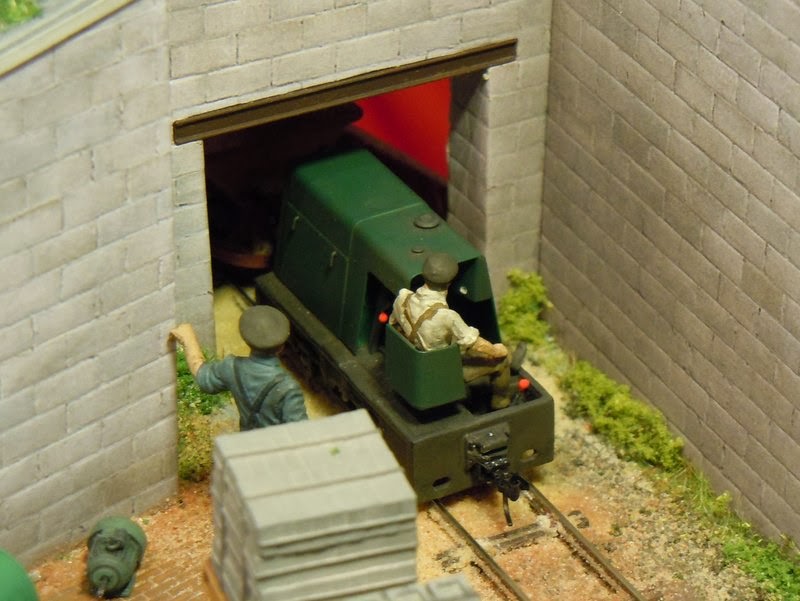The foreman watches on as the skips are filled with sand under the hoppers. The track in this area is almost buried under spilt sand. The loco is a Hudson Hunslet built in the mid 1950's.
Looking down from the top of the path to the hoppers we see the train climbing the gradient to the tipping shed, the two colours of sand in the skips can be seen clearly. The loco is passing the engine shed on the left, while on the right pallet-loads of concrete blocks, kerb-stones, and paving slabs await dispatch.
That last picture has been posed to match the photo on the cover of Graham Lelliot's book about the line, which was the inspiration for this model. I think I've captured the essence of the site, though as you can see, I could do with a lot more pallets of concrete products!
As the train passes the engine shed we see that another loco waits in the doorway, perhaps it has been pushed out for maintenance under better light, or just to make more space for work in the shed? This is a pre-war O&K and is showing it's age with flaky rust breaking through the paint, while the newer Hudson is a little grubby but well kept. In the foreground the "portable" track sections can be discerned, with steel sleepers and even the fishplates visible. In places wooden sleepers can be seen under the steel ones, though the sand does seem to get everywhere!
On the footpath that crosses the site a Labrador listens to the rumble of the train over the steel bridge above, as it enters the tipping shed. Or has he seen a rabbit? His master waits nearby.
The bridge still stands today, though there are no trains, just a conveyor belt. (The striped beam in the foreground carries a pipe, and I omitted it from the model)
With the skips emptied into the appropriate chutes in the tipping shed the loco slowly pushes them back over the bridge, and past yet more concrete products.
In the yard a local team of builders have arrived to pick up some paving slabs, though they seem to be distracted arguing about whose turn it was to clean the van. In the background are rows and rows of concrete slabs, and piles of pallets waiting to be used. The footpath cuts though the site on the left.
The train rattles back down the grade to the sand hoppers, to repeat the process again and again. Behind the skips can be seen the steps up to the top of the hoppers, which are set into the old quarry, though now the sand arrives by road.
At the end of the day the skips have been left near the hoppers, while a spare skip wagon is in the siding by the shed. The skip body is upended in the bushes, presumably to prevent it filling with water. The O&K has been pushed back into the shed - mysteriously, it also seems to have turned around!
Thakeham Tiles will be at the SWING narrow gauge show in Bognor on the 17th May.










No comments:
Post a Comment